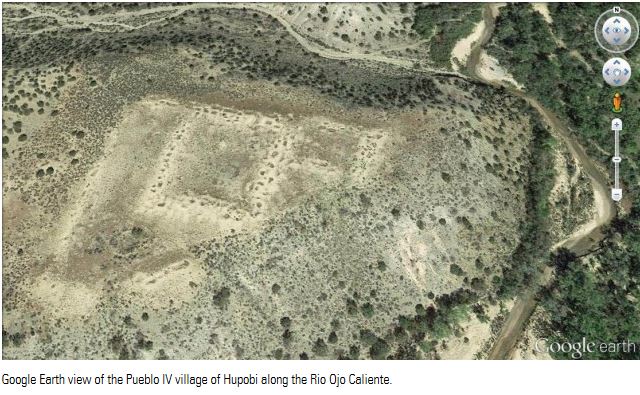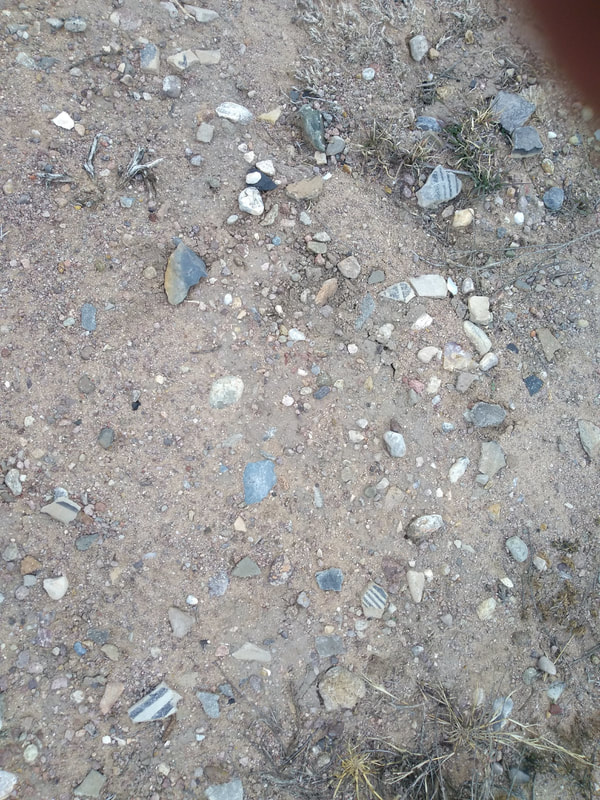 Looking down from the mesa top where Posi is.
Looking down from the mesa top where Posi is.This weekend I visited Ojo Caliente, a small town in Northern New Mexico, 50 miles north of Santa Fe. Ojo Caliente is Spanish for “warm eye,” and refers to the opening of a series of hot springs.
The valley in which Ojo Caliente lies has been inhabited a long time. The first known inhabitants emigrated from the Four Corners area in the late 1200s. They were a Tewa-speaking people, and they built a number of large pueblos, many of which had 2,000 or more rooms. The one closest to modern-day Ojo Calente is Posi-Ouinge, the 'Greenness Pueblo,' named such because of the green algae that clung to the rocks near the hot spring. The Tewas maintain that its pools provide access to the underworld. Posi-Ouinge was occupied from the 13th through the 16th century, when an epidemic caused the inhabitants to abandon the pueblo and move to Oke-onwi, also known by its Spanish name, San Juan.
The valley in which Ojo Caliente lies has been inhabited a long time. The first known inhabitants emigrated from the Four Corners area in the late 1200s. They were a Tewa-speaking people, and they built a number of large pueblos, many of which had 2,000 or more rooms. The one closest to modern-day Ojo Calente is Posi-Ouinge, the 'Greenness Pueblo,' named such because of the green algae that clung to the rocks near the hot spring. The Tewas maintain that its pools provide access to the underworld. Posi-Ouinge was occupied from the 13th through the 16th century, when an epidemic caused the inhabitants to abandon the pueblo and move to Oke-onwi, also known by its Spanish name, San Juan.

Spanish settlement at Ojo Caliente began in the early 1700s, when it and other outposts were established to protect populations centers such as Santa Fe and Santa Cruz from raids by the Utes, Comanches and other tribes. These isolated outposts were settled by Mexican Indians, mixed-blood Spaniards, and genizaros, Indians who were sold as slaves to the Spanish and became household servants. Some of the Spanish had Jewish or Muslim ancestry and continued to practice their traditional rituals in secret. Others adopted traditions from the surrounding Indians, creating a unique culture.

The hike to Posi-Ouige begins directly behind the resort where the hot springs are located. After a short, scrambly climb, the trail follows the top of the ridge to the edge of the mesa. There are no walls left, and only the use of my admittedly fertile imagination gave me any sense that I was standing in a place that had once housed hundreds of people. But the ground was littered with more pottery shards than I had ever seen in one place before. Some had been laid on flat rocks, but many more pieces were underfoot. I’m no archaeologist, but the sheer number of pot shards told me that a lot of people had lived here.
 This is a near-by ruin. The one I visited was not anywhere near this evident.
This is a near-by ruin. The one I visited was not anywhere near this evident.https://www.archaeologysouthwest.org/2014/12/03/return-to-the-ojo-caliente-valley/
https://www.blm.gov/visit/posi-ouinge
http://dev.newmexicohistory.org/filedetails.php?fileID=4767
https://www.blm.gov/visit/posi-ouinge
http://dev.newmexicohistory.org/filedetails.php?fileID=4767
Jennifer Bohnhoff is a New Mexico native who teaches middle school English in a rural part of the state She is the author of several novels, including one set in New Mexico during the Civil War. You can learn more about her books here.







No comments:
Post a Comment